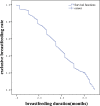Factors associated with post NICU discharge exclusive breastfeeding rate and duration amongst first time mothers of preterm infants in Shanghai: a longitudinal cohort study
- PMID: 35501877
- PMCID: PMC9063107
- DOI: 10.1186/s13006-022-00472-x
Factors associated with post NICU discharge exclusive breastfeeding rate and duration amongst first time mothers of preterm infants in Shanghai: a longitudinal cohort study
Abstract
Background: Breastfeeding is crucial for the preterm infants. Breast milk is not only food but also medicine. Few studies have focused on the longitudinal effects of exclusive breastfeeding outcome of preterm infants separated from their mothers after discharge, especially in Shanghai. We aimed to examine the exclusive breastfeeding rate and duration amongst first time mothers of preterm infants after discharge and its determinants.
Methods: Analyses were based on 500 preterm infants separated from their mothers in a tertiary maternity and infant-specialized hospital in Shanghai from September 2018 to September 2019.The Socio-demographic characteristics, breastfeeding knowledge questionnaire, breastfeeding self-efficacy short form scale, Edinburgh postpartum depression scale and breastfeeding family support scale were used for the investigation and the exclusive breastfeeding rate of premature infants was followed up on 1 month, 3 months and 6 months after discharge. The changing trend of breastfeeding knowledge, breastfeeding self-efficacy, postpartum depression and family support were measured by ANOVA at different stages. Using the chi-square test and multiple logistic regression, factors impacting the breastfeeding rate of preterm infants at three time intervals after discharge were investigated. The Kaplan Meier survival curve and cox regression model were used to analyze the determinants of exclusive breastfeeding duration of premature infants after discharge.
Results: Exclusive breastfeeding rates were 19.0, 17.2 and 10.4% at 1 month, 3 months and 6 months after discharge of preterm infants, respectively. The average length of exclusive breastfeeding duration was(3.69 ± 1.80)months. Finally, type of delivery (adjusted odds ratio [AOR] 1.564; 95% confidence interval [CI] 0.513,3.116), gestational age(AOR 0.612, 95% CI 0.236, 3.418), maternal family support (AOR 6.125,95% CI 6.359, 98.452) were discovered to be independent predictors on the exclusive breastfeeding rate at 6 months after preterm infants were discharged. Through the cox regression model, we found that a maternal planned pregnancy (HR 0.681, 95%CI 0.531,0.873), delivering breast milk during hospitalization (HR 0.797, 95%CI 0.412,2.288), NICU feeding mode during hospitalization (HR 1.221, 95%CI 0.128,1.381) and family support (HR 0.561, 95%CI 0.004,2.428) were significantly associated with the exclusive breastfeeding duration after discharge.
Conclusions: The exclusive breastfeeding outcome of premature infants was affected by many factors, so we should focus on the three levels of individual, family, society and design targeted intervention measures to increase the exclusive breastfeeding rate and prolong exclusive breastfeeding duration.
Keywords: After discharge; Determinants; Exclusive breastfeeding duration; Preterm infants separated from their mothers.
© 2022. The Author(s).
Conflict of interest statement
The authors declare that they have no competing interests.
Figures



Similar articles
-
Factors Affecting Breastfeeding Outcomes at Six Months in Preterm Infants.J Hum Lact. 2019 Feb;35(1):80-89. doi: 10.1177/0890334418771307. Epub 2018 May 3. J Hum Lact. 2019. PMID: 29723482
-
Analysis of the duration of exclusive breastfeeding in premature infants and its influencing factors.J Pediatr Nurs. 2023 Nov-Dec;73:e180-e186. doi: 10.1016/j.pedn.2023.09.002. Epub 2023 Oct 5. J Pediatr Nurs. 2023. PMID: 37805377
-
A prospective cohort study on lactation status and breastfeeding challenges in mothers giving birth to preterm infants.Int Breastfeed J. 2022 Jan 10;17(1):6. doi: 10.1186/s13006-021-00447-4. Int Breastfeed J. 2022. PMID: 35012631 Free PMC article.
-
Nutrition, growth, and allergic diseases among very preterm infants after hospital discharge.Dan Med J. 2013 Feb;60(2):B4588. Dan Med J. 2013. PMID: 23461996 Review.
-
An integrative review of factors that influence breastfeeding duration for premature infants after NICU hospitalization.J Obstet Gynecol Neonatal Nurs. 2014 May-Jun;43(3):272-81. doi: 10.1111/1552-6909.12297. Epub 2014 Apr 1. J Obstet Gynecol Neonatal Nurs. 2014. PMID: 24689979 Review.
Cited by
-
Determinants of delayed onset of lactogenesis II among women who delivered via Cesarean section at a tertiary hospital in China: a prospective cohort study.Int Breastfeed J. 2022 Nov 30;17(1):81. doi: 10.1186/s13006-022-00523-3. Int Breastfeed J. 2022. PMID: 36451171 Free PMC article.
-
The effect of family integrated care on the prognosis of premature infants.BMC Pediatr. 2022 Nov 19;22(1):668. doi: 10.1186/s12887-022-03733-0. BMC Pediatr. 2022. PMID: 36403036 Free PMC article. Clinical Trial.
-
Longitudinal studies on breastfeeding among preterm infants: a scoping review.BMC Pregnancy Childbirth. 2025 Jul 9;25(1):738. doi: 10.1186/s12884-025-07837-0. BMC Pregnancy Childbirth. 2025. PMID: 40634838 Free PMC article.
-
Factors associated with high exclusive breastfeeding rates among preterm infants under 34 weeks of gestation in Da Nang, Vietnam: A retrospective cohort study.J Glob Health. 2023 Nov 9;13:04121. doi: 10.7189/jogh.13.04121. J Glob Health. 2023. PMID: 37934970 Free PMC article.
-
Human Milk Feeding Is Associated with Decreased Incidence of Moderate-Severe Bronchopulmonary Dysplasia in Extremely Preterm Infants.Children (Basel). 2023 Jul 23;10(7):1267. doi: 10.3390/children10071267. Children (Basel). 2023. PMID: 37508764 Free PMC article.
References
Publication types
MeSH terms
LinkOut - more resources
Full Text Sources
Medical

